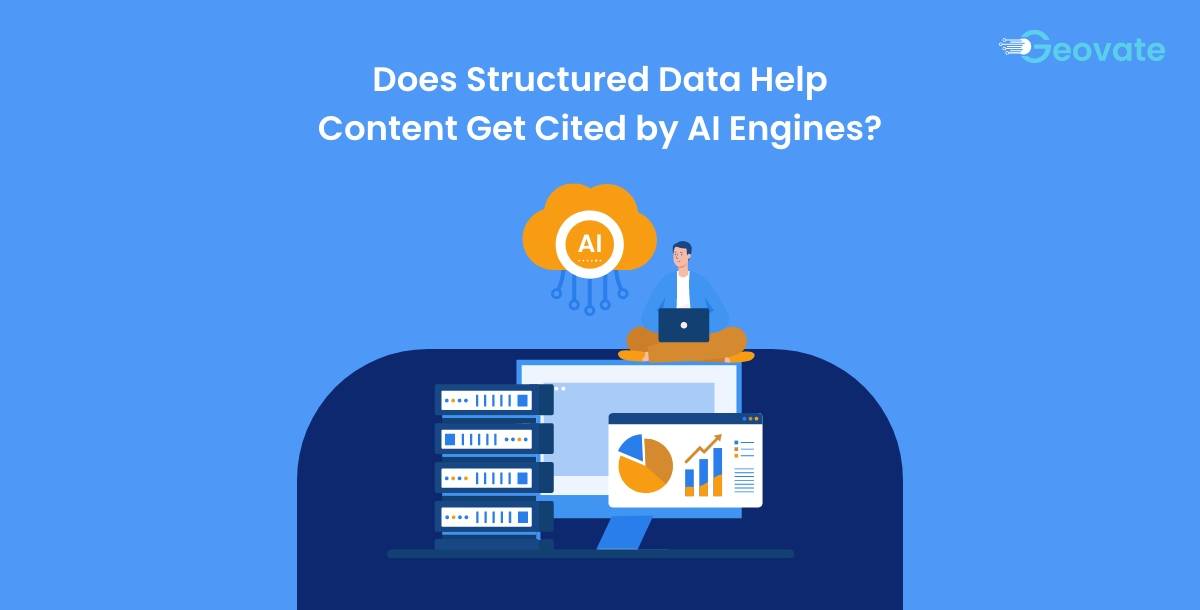Does Structured Data Help Content Get Cited by AI Engines?
Tue,09 Sep 2025 12:49:00- Font Size
- Share Content

Introduction
The way people find information online is evolving rapidly. Traditional search engine optimization (SEO) strategies—focused on ranking in Google’s blue links—are being reshaped by the rise of Generative AI engines like ChatGPT, Perplexity, Gemini, and Google’s Search Generative Experience (SGE). These platforms no longer just index and rank pages; they summarize, cite, and generate answers.
This shift has given rise to Generative Engine Optimization (GEO), a new discipline aimed at making content visible and credible in AI-generated results. A key question in this field is:
Does structured data (schema markup) increase the likelihood of being cited by ChatGPT and other AI engines?
Recent case studies and industry observations strongly suggest that yes—it does. Let’s explore why structured data may be one of the most powerful levers for boosting AI visibility and how businesses can integrate it into their GEO strategy.
1. What Is Structured Data?
Structured data refers to machine-readable markup embedded in web pages, usually in JSON-LD format, that describes the meaning and relationships of content.
For example:
- A Product schema can specify a product’s name, price, ratings, and availability.
- An Article schema can identify the headline, author, publication date, and topic.
- An FAQ schema lists questions and answers in a standardized way.
This markup helps search engines and AI models understand not just the words on a page, but also the context and relationships between entities.
2. Why Structured Data Matters for Generative Engines
Unlike Google’s traditional algorithm, AI engines don’t just retrieve—they generate responses. When ChatGPT or Gemini composes an answer, it needs:
- Reliable sources (to reduce hallucinations).
- Context-rich signals (to understand intent and relevance).
- Entities it can map to knowledge graphs (people, organizations, products, places).
Structured data delivers exactly that. It bridges the gap between unstructured text and machine understanding. By feeding AIs clean metadata, businesses make their content easier to discover, parse, and cite.
3. Evidence Linking Structured Data to AI Citations
Case Example: FindThisBest
One striking example comes from an e-commerce comparison site, FindThisBest. Despite receiving penalties that hurt its Google rankings, it still appeared as a cited source in ChatGPT.
Why? Analysts believe it’s because the site heavily used Product structured data, making its pages more accessible to AI retrieval.
Industry Observations
- Geovate’s AI Tracker noticed that many highly-cited sources in ChatGPT queries had strong schema implementations, especially in niches like shopping and reviews.
- Generative engine audits show that content with
FAQPageandHowToschema is disproportionately included in AI answers, since this structure mirrors conversational Q&A formats. - Knowledge graphs (e.g., Wikidata, Crunchbase, LinkedIn) feed into AI training, and structured data often acts as the bridge connecting your site to those entities.
While causation is hard to prove, the correlation is too strong to ignore.
4. Types of Schema That Boost AI Visibility
Not all schema is equal. Some types are particularly influential for GEO and AI citations:
1. Article/Blog Posting Schema
- Essential for thought leadership, it ensures authorship and topical relevance are clear.
- Helps AI engines attribute credibility.
2. Product Schema
- Covers name, description, SKU, price, reviews, and availability.
- Especially important for e-commerce GEO strategies.
3. FAQ Page Schema
- Mirrors the Q&A format of generative responses.
- Boosts inclusion in conversational AI answers.
4. HowTo Schema
- Structured step-by-step guidance, ideal for tutorials or DIY content.
- AI models prefer this schema because it maps directly to procedural generation.
5. Organization & Person Schema
- Strengthens brand/entity recognition.
- Links content to authoritative knowledge graph entries.
5. Structured Data as a GEO Strategy
Structured data is no longer just about winning rich snippets in Google. In the era of AI, it’s becoming the infrastructure of visibility. Here’s how to align it with GEO strategy:
- Entity Alignment: Ensure your schema clearly links authors, organizations, and topics to recognized entities (e.g., Wikidata, Google Knowledge Graph).
- Comprehensive Coverage: Don’t stop at Article schema—use layered markup (FAQ + HowTo + Author).
- Trust Signals: Include
author,review, andpublishermetadata to improve credibility. - Consistency Across Platforms: Sync schema with external profiles (LinkedIn, Crunchbase, Google Business Profile). AI models consolidate these signals.
6. Practical Steps for Implementation
1. Audit Your Current Markup
- Use Google’s Rich Results Test or Schema.org Validator.
- Identify missing or invalid schema.
2. Prioritize High-Value Pages
- Focus on product pages, cornerstone blog posts, and FAQs.
- These are most likely to be cited in AI responses.
3. Expand Entity Connections
- Add schema fields that tie your content to external identifiers.
- Example:
sameAslinking to Wikidata, LinkedIn, or official profiles.
4. Monitor AI Mentions
- Track when and how your site is cited in ChatGPT or Perplexity.
- Use tools like AI citation trackers to measure progress.
5. Iterate for GEO
- GEO is evolving—test, analyze, and refine your structured data strategy regularly.
7. Beyond Structured Data: Complementary GEO Tactics
While schema is crucial, it should work alongside other Generative Engine Optimization strategies:
- Content Depth & Coverage: Comprehensive, prompt-friendly content is more likely to be cited.
- Topical Authority: Build clusters of interlinked content around key themes.
- Freshness Signals: Update publication dates and schema to stay relevant in AI answers.
- Multimodal Optimization: As AI engines integrate images, video, and audio, structured metadata for multimedia will grow in importance.
8. The Future of Structured Data and AI
Structured data is becoming the currency of trust in AI-driven search. Just as backlinks powered SEO’s first wave, schema markup may power the next. In the coming years, expect to see:
- New schema types emerging specifically for AI engines.
- Direct integrations between schema markup and knowledge graphs.
- AI citation algorithms weighing structured data as heavily as backlinks once were.
Businesses that embrace structured data today will be ahead of the curve in AI-driven visibility tomorrow.
Conclusion
So—does structured data influence ChatGPT citations? While hard data is still emerging, the evidence strongly suggests that yes, it plays a critical role. Structured data doesn’t just help AI understand your content; it helps AI trust, retrieve, and cite it.
For businesses navigating the era of Generative Engine Optimization, schema markup is no longer optional. It’s the foundation of visibility in AI-driven search, and those who adopt it early will shape how their brand is discovered in the age of generative engines.
Frequently Asked Questions
Q1. Does structured data help content get cited by ChatGPT?
Yes. While not officially confirmed, evidence shows that sites using schema markup—such as Product or FAQ schema—are more likely to be cited by ChatGPT. Structured data makes content easier for AI engines to parse, trust, and surface in generated answers.
Q2. What types of schema are most effective for AI and GEO?
The most impactful schema types include Article, Product, FAQPage, HowTo, and Organization/Person schema. These formats provide structured signals that map well to how generative engines like ChatGPT summarize and cite content.
Q3. Is structured data still useful if my site doesn’t rank well on Google?
Absolutely. Even if a site struggles in traditional search rankings, structured data can improve visibility in AI-generated platforms. For example, FindThisBest was cited by ChatGPT despite weak Google rankings, largely due to its Product schema.
Q4. How can I add structured data to my website?
You can implement schema markup using JSON-LD code in your site’s HTML. Popular CMS platforms (like WordPress, Shopify, or Wix) offer plugins and built-in tools to add structured data. Always validate your markup using Google’s Rich Results Test or Schema.org Validator.
Q5. What is the connection between structured data and Generative Engine Optimization (GEO)?
Structured data is a foundation of GEO. By making your content machine-readable and entity-linked, schema markup helps generative engines understand and trust your site. This increases the chance of being cited in ChatGPT, Gemini, or Perplexity answers.
